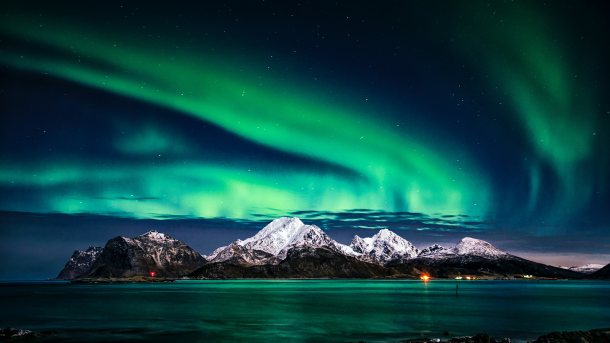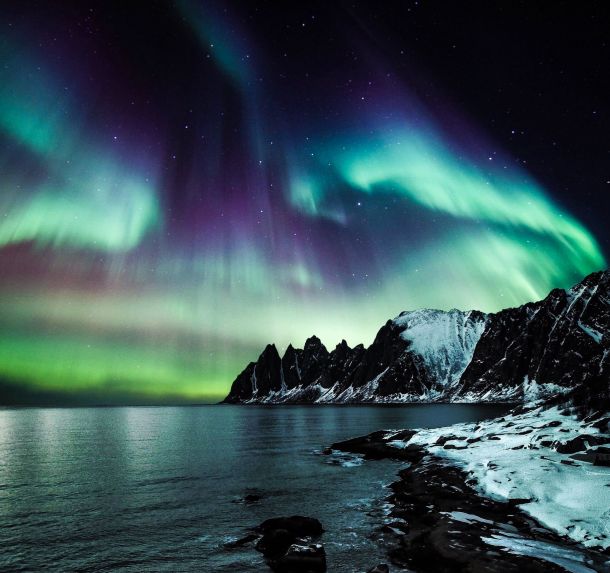
Photo by stein egil liland from Pexels.
Aurora: a colorful light show in the sky caused by the interaction between Earth’s magnetic field and charged particles from the sun.
AKA: polar lights (aurora polaris), northern lights (aurora borealis), or southern lights (aurora australis).
An aurora is a natural light display in the Earth’s sky, predominantly seen in high-latitude regions. Auroras are the result of disturbances in the magnetosphere caused by solar wind.
The word “aurora” is derived from the name of the Roman goddess of the dawn, Aurora, who traveled from east to west announcing the coming of the sun.
Cause:
Auroras are caused by the interaction of energetic particles (electrons and protons) of the solar wind with atoms of the upper atmosphere. When protons and electrons stream out from the solar surface, they then slam into Earth’s magnetic field, which shields Earth’s surface from most of the energy and particles that come from the sun. These charged particles move in spirals along the magnetic field lines. Those particles in turn hit the atmosphere. As they follow the magnetic field lines, most of them enter the atmospheric gases in a ring around the magnetic poles, where the magnetic field lines come together.
They then collide with oxygen and nitrogen atoms, knocking away electrons to leave ions in excited states. The particles interact with gases in Earth’s atmosphere resulting in beautiful displays of light in the sky. Oxygen typically glows green and red, while nitrogen gives off blue and purple light.
While scientists have long hypothesized the cause of auroras, it wasn’t until recently that they knew for sure. According to an article published on June 7, 2021, in the journal Nature Communications, auroras starts when disturbances on the sun pull on Earth’s magnetic field, creating cosmic undulations known as Alfvén waves that launch electrons at high speeds into Earth’s atmosphere where they create the aurora.
It had been long suspected that Alfvén waves played a role in speeding up electrons, resulting in these beautiful light shows, but the results of this lab experiment are the only definitive proof. The scientists gathered their data using a Large Plasma Device at the Basic Plasma Science Facility at UCLA to re-create the interaction between Alfvén waves and electrons. Using such a device allowed the researchers to limit other factors and to not have to plan their research around an aurora event, whose timing is widely a mystery, which they would not have been to do in space. This research will help scientists to better understand how particles are energized and how events on the sun affect the space near Earth.

Polar aurora, Iceland Feb. 2014. Canon EOS 400D, 17mm-f2,8- Iso 1600. First row exposure time 30-20sec, with the naked eye slightly visible. Second row exposure time 4sec., clearly visible. (Credit: Schnuffel2002)
Appearance:
Auroras are best seen at night. They take many colors and forms. The lights are often green and red, but also purple, blue and yellow. Some of the forms include luminous curtains, arcs, bands, and patches.
Auroras are shaped by Earth’s magnetic field, and these forms are consistent with this formation. The appearances of arcs, rays, curtains, and coronas are determined by the shapes of the luminous parts of the atmosphere, as well as a viewer’s position.
The uniform arc is the most stable form. It can persist for hours without noticeable variation. Other forms may appear during a great display and this uniform arc can undergo dramatic variation.

Photo by Tobias Bjørkli from Pexels.
Geography:
Auroras primarily occur in high latitudes of both hemispheres in areas known as the ‘auroral zone.’ These areas are near the poles of the Arctic in the north and Antarctic in the south.
While auroras are most often found in the auroral zone, they are occasionally seen in latitudes below the auroral zone. They can be found at lower latitudes when a geomagnetic storm temporarily enlarges the auroral oval. Large geomagnetic storms often occur during the peak of the 11-year sunspot cycle. These large storms may also occur during the three years after the peak.
Auroras are not only found on Earth but also on other planets, including Saturn and Jupiter. A planet will likely have auroras if it has an atmosphere and magnetic field, they probably have auroras. Similar to Earth, the lights have been seen near these planet’s magnetic poles.
Source: NASA and Encyclopaedia Britannica
